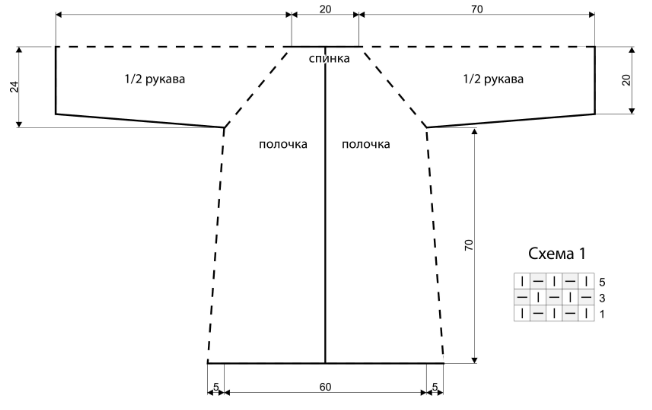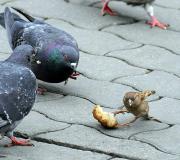A coat with a knitted collar is the trend of the season! Collar pattern. Knitted coat elements
Women's coat with collar it will look great. Patterns and descriptions of knitting coats for women on knitting needles.
Size: 44
You will need for knitting: cherry-colored yarn 800 g (50% wool, 50% acrylic, 300 m/100 g), circular knitting needles No. 4, 5 buttons to match the yarn.
Garter stitch: knit front and back rows with purl loops.
Pearl Pattern: knit according to pattern 1. The diagram shows the front rows, knit the purl rows according to the pattern. Repeat in height from rows 1 to 4.
Main pattern: knit according to pattern 2. The diagram shows the front rows, knit the purl rows according to the pattern. Repeat in height from the 13th to the 42nd row.
Attention! knit in one piece from top to bottom.
Coat with a collar with knitting needles description and diagrams
Cast on 90 stitches and knit with a pearl pattern, simultaneously forming raglan lines.To do this, distribute the loops in the following way: for the raglan line - 2 sts, for the sleeves - 14 sts, for the back - 16 sts, for the shelves - 18 (7 sts - with a pearl pattern according to scheme 1, 10 sts - with a scarf viscous, chrome). On the bar of the right shelf, make buttonholes at equal distances from each other.
To form bevels on both sides of the raglan line loops in each front row, add 1 stitch 18 times. At a height of 24 cm from the cast-on row, place the sleeve loops on additional knitting needles.
Knit the back and front in one fabric with the main pattern according to pattern 2.
Evenly across the entire width of the fabric in each repeat in height, at the beginning of knitting a diamond, add 2 stitches in each diamond. At a height of 90 cm from the cast-on row, close the loops.
Transfer the sleeves to the main knitting needles and continue knitting according to pattern 2. To narrow the sleeves on both sides, in every 6th front row, cast off 12 times, 1 st. At a height of 70 cm from the cast-on row, close the loops.
Assembly: sew the sleeves. To decorate the neckline, cast on stitches from edge stitches and knit 20 cm in garter stitch. Sew buttons.
http://www.crafterbynight.com/tag/pattern/
In the photo: this elegant knitted piece of clothing is called a “cape”. It's essentially a removable collar. Unfortunately, the scheme and step by step instructions The author sends knitting materials only for money, for $4.96.
In the winter of 1963-1964 in the USSR, it was fashionable to trim dresses, jackets, blouses, and coats with woolen knitted collars, flaps, cuffs, and also to combine garments with knitwear (sleeves, shirtfronts, shelves, etc.). Since the 1960s fashion for large, bright scarves and scarves has returned to us, finishing clothes with large knitted collars and cuffs is also probably relevant again.
I bring to your attention several models of dresses and coats with hand-knitted jersey.
 Model 1
Model 1
Elegant one piece dress Made from black wool crepe with long sleeves. The sporty nature of the dress is emphasized by the collar, which is slightly behind the neck, and the cuffs, knitted from black wool. The knitted placket is thrown over the collar and attached at the top with a large button. A second button is sewn on the lower end of the placket.
Spokes- Nos. 3.5 and 2.
Mating: 1. Elastic band 1 X 1 - alternating one knit stitch with one purl loop.
2. Relief elastic band. The number of loops in a row must be odd. (The first and last edge loops are not included in the description.)
1st row: 1 knit stitch, 1 slip crochet stitch (thread the yarn over the left knitting needle as for knitting a purl loop, and slip the loop and yarn over onto the right knitting needle without knitting). This is how the loops alternate until the end of the row.
2nd row: 1 purl loop, 1 loop and yarn over from the previous row are knitted together with a knit loop. And so on until the end of the row. Next, repeat the 1st and 2nd rows.
Collar
Cast on approximately 100-110 loops on knitting needles No. 3.5 and knit a straight strip with a 10 cm high raised elastic band. Then switch to knitting needles No. 2 and knit another 2 cm with a 1 X 1 elastic band, after which all the loops are secured in one row.
The collar is slightly smoothed through a damp cloth, and its lower edge is slightly stretched. The finished collar is sewn and inserted into the neckline.
Plank
Cast on 19 loops on needles N 3.5 and knit a strip 65-70 cm long with a relief elastic band, after which all the loops are secured in one row.
Cuffs
Cast on 45-50 loops using no. 2 knitting needles and knit a straight strip with a 1 X 1 elastic band, 8 cm high, after which all loops are secured in one row.
Model 2
Simple but elegant dress made of soft wool fabric straight cut with set-in sleeves, without collar. There is a knitted trim around the neck, turning into a vertical strip. Knitted cuffs. The trim is knitted from woolen threads of the same color as the dress, or in a harmonizing tone. For example: light green dress with dark green trim, yellow dress with brown trim, etc.
Amount of wool - 70 g.
Spokes - № 2.
Mating– elastic band 1X1 – alternating one knit stitch with one purl stitch.
Trim around neckline and placket
Cast on 140 - 150 stitches and knit a straight strip with a 1X1 rib. Having knitted 2 cm after the first six loops from the edge, make a buttonhole (fasten 3 loops, which are made up in the next row). Having tied a strip 3.5 cm high, leave open first 15 loops, and all the rest are closed in one row. These 15 loops are for the bar. They continue to be knitted in a straight stripe. At 16 cm after the first six loops from the edge, make a second loop for the button (fasten 3 loops, which are made up in the next row).
Having knitted a strip 29 cm long, begin to form the toe. To do this, fasten one loop on both sides in each front row until all the loops are secured.
The finished trim is sewn to the neckline so that the free end goes under the placket. A button is sewn on the end of the binding. The strip can be sewn into dress or attach on top.
Cuffs
Cast on 50 - 55 loops and knit a straight strip 6 cm high with a 1X1 elastic band, after which all loops are secured in one row.
Model 3
Continuous waist dress with set-in sleeves made of woolen fabric. The shirtfront is knitted from wool. The combination of colors of the dress and shirtfront may be different. It is important that they are in harmony.
Amount of wool - 120 g.
Spokes - № 2.
Mating- 1X1 elastic band - alternating one knit stitch with one purl stitch.
Dickey
The shirt front is knitted from two halves. For the right half, cast on 10 loops and knit with an elastic band, adding from the side that will be sewn to the dress, every 0.5 cm, first three times 5 loops, and then six times 2 loops. Next, knit without changes to the shoulder.
From the fastener side, knit straight to the neckline. At 10 cm from the bottom, after the first 3 loops from the edge, make a buttonhole (fasten 4 loops, which are made up in the next row). At 17 cm from the bottom, they begin to form a neckline, securing every 0.5 cm, first three times with 8 loops, and then three times with 3 loops. The remaining 4 loops are knitted up 1 cm and secured in one row.
The left half of the shirtfront is knitted in the same way as the right, but without a buttonhole.
Description of knitting is different.
Collar
Cast on 160 loops and knit a straight strip 13 cm high, after which all loops are secured in one row.
Insert both halves of the shirtfront into the neckline of the dress and sew them on.
Cuffs
Cast on 48 loops and knit a straight strip 8 cm high, then fasten all the loops in one row.
Model 4
If you have a very frayed side or collar of your fur coat, you can easily correct this defect by knitting a strip of woolen thread in the same color as the fur.
To determine the required number of loops for a knitted strip, cast on 35-40 loops on knitting needles and knit a strip 3-4 cm high for a sample. Then lightly iron the sample and, stretching it slightly, count the number of loops per 10 cm. Accurately measure the length of the side fur coats and calculate the required number of loops for the strip. For example, if the length of your side is 104 cm, and linked sample If you determine that there are 25 loops per 10, then for the stripe you need to cast on 260 loops on the knitting needles.
Having collected the required number of loops, knit a straight strip 4 cm high with a 1X1 elastic band, and then, for hemming, with thinner threads another 4 cm in stocking knitting, after which all the loops are secured in one row.
To determine the required number of loops for edging the collar, apply the knitted strip for the edge to the edge of the collar and count the loops. To make a beautiful angle (turn) on the edging, count the required number of loops before each turn and take one loop at the turn as the “central”. Then the loops are picked up and a strip is knitted, in each front row of which one loop is added before and after these “central” loops.
Having knitted 4 cm in this way, they switch to thinner threads and stockinette knitting and knit a hem. In each front row of the hem, before and after the “central” loops, one loop is decreased. Having knitted 4 cm of hems, fasten all the loops in one row.
Model 5
Women's sports jacket made of thick woolen fabric in bright blue color. The turn-down collar and flaps are knitted, white, they are sewn onto the collar and flaps of the finished jacket. Fastening with two large white buttons of a simple shape. There is a seam and a cut (slit) on the back.
Amount of wool - 80 g.
Spokes- Nos. 3 and 2.
Mating- large elastic band. The number of loops in a row should be odd. (The first and last edge loops are not included in the description.)
1st row: 1 knit stitch, 1 slip crochet stitch (thread the yarn over the left knitting needle, kick to knit the purl loop, and slip the loop and yarn over to the right back without knitting). So alternate until the end of the row.
2nd row: 1 slip double crochet, 1 double crochet from the previous row is knitted together with a knit stitch. Then alternate until the end of the row.
3rd row: 1 loop and yarn over from the previous row are knitted together with a knit loop, 1 loop is removed with a yarn over, etc.
The collar and flaps are knitted in a straight strip 1.5 cm less than the width and length of the collar and flaps of the finished jacket. To make the collar fit better to the neckline, the last 4 rows are knitted with a 1X1 elastic band on thinner knitting needles.
Model 6
The combination of fabric and knitwear on children's coats is interesting. The model shows a children's coat made of bright red cloth. The collar, cuffs and cap are knitted from white wool. The collar and cuffs are sewn on top of the finished parts.
The amount of wool for the collar, cuffs and hat is 150 g.
Spokes- Nos. 3.5 and 2.
Mating: 1. Elastic band 1 X 1 - alternating 1 knit stitch with one purl stitch.
2. Elastic 1X2 - alternating one front loop with two purl ones.
3. Stocking - alternating one row of knit stitches with one row
purl.
4. Large English elastic band. (For pattern description, see model 5.)
The collar and cuffs are knitted in a straight strip with a large elastic band according to the size of the collar and cuffs finished coat. To make the collar fit better to the neckline, the last 4 rows are knitted with a 1X1 elastic band on thinner knitting needles.
To calculate the required number of loops, you must first knit the sample. (See description for model 4.)
In addition, you can sew or knit with ruffles in a completely different style.
Knitting a hat for a child
Cast on 91 loops on needles No. 2 and knit 2 cm with a 1X1 elastic band. Next, decrease 10 stitches evenly along the entire row, switch to needles No. 3.5 and knit with a large 12 cm elastic band without changes, and then again switch to thin knitting needles and knit 5 cm with a 1X1 elastic band. After this, they begin to decrease the loops to form the bottom of the cap: they switch to a 1X2 elastic band, simultaneously decreasing 20 loops in one row. Knit up 2 cm and switch to 1X1 rib, decreasing 19 stitches in one row at the same time. Knit another 2 cm and switch to stockinette knitting, simultaneously decreasing 21 loops in one row. Next, 1 cm is knitted in stocking stitch and another 10 stitches are decreased along the entire row. The remaining 11 loops are transferred to a needle and thread and tightened tightly.
The cord and brush do this:
The thread is folded several times, one end is secured, and the other is tightly twisted in one direction, then both ends of the twisted thread are folded together, holding its middle with the left hand, and released. The thread twists and turns into a cord. To prevent the ends of the cord from unraveling, they need to be tied in a knot or tied with thread.
A brush is attached to the cord, which is made as follows: a thread is tightly wound around the four fingers of the left hand. Then they cut it with scissors. Place a cotton ball in the middle and tie it tightly with a thread below the ball. The ends of the brush are trimmed evenly.
Interesting article? Tell your friends. Dear reader of the allforfamily blog! If you have any questions, objections, thoughts, please leave your comment. It is important for me, the author, to know your opinion.. Please also let me know if any link in the article does not open.
> Knitted coat elements
Knitted coat elements
Soft knitwear, delicate wool - all this is associated with warmth and comfort. That's why we love to throw on a grandma-knitted sweater or soft cardigan and cozy up with a book or cup of coffee in hand. World designers turn our habits into trends and fulfill the wishes of their fans. In the new autumn-winter season, they boldly use knitted elements in outerwear, which go well with natural fabrics. Cashmere, wool and knitted details are so close that their coexistence in one product is absolutely logical. Moreover, new textures bring fresh notes to the image, allow you to play with shades and add volume. And wearing such things is a pleasure. They are soft and can be easily rolled up and taken with you. When you take your coat out of the closet, you'll never have to worry about whether the collar is wrinkled.
The original textures of knitted elements add zest to the look
In designer collections of women's coats, knitted elements have already become a real decoration of the models. They appear along the front lines, on the sleeves and collars. This season, boucle knitting is on trend, adding texture. It can be the same tone as the main product or a complementary shade. Such options look multi-layered and at the same time are not devoid of elegant and romantic notes. You don't have to worry if there is a sharp drop in temperature outside the window. You definitely won't freeze in these coats.
Knitted collar
Classic English, stand-up or shawl collars - elegance never goes out of style
We all love warm knitted scarves. Have you tried replacing them with a luxurious knitted collar? Residents of New York, Paris, and London have already picked up this fashion trend, which came from the catwalks and is proving its attractiveness with might and main. Today, such things with a slight retro touch are becoming a must-have of the season. Designers advise maintaining a single color scheme, however, playing with tones is not forbidden. Knitted collar can be boucle and voluminous or quite minimalistic, depending on your style and individual preferences. But, of course, he will become central to the image.
All the best from Teresa Tardia
Elegant fitted creations from Italy
European designers make fashion exclusive, making every element of the look exceptional. Therefore, you should definitely take a closer look at the trends from the catwalks and turn them into part of your style. In the new autumn-winter season, couturiers are ready to offer classic coats Made from high quality Loro Piana wool with a knitted shawl collar. The Italian brand Teresa Tardia is widely known for its trendy models. outerwear and use latest technologies production of materials with moisture- and dirt-repellent properties. In the catalog of exquisite coats, the wool of which will surprise anyone, the online store PukupkaLux now offers to purchase your favorite coat model with knitted elements, and consultants will help you choose right size in accordance with the characteristics of the figure.
Knitted sleeves and cuffs
Keep your hands warm
Another fashion trend The autumn-winter season includes knitted sleeves. They look more like a jumper worn under a coat. This design solution is also reminiscent of a favorite accessory among young people - mitts. Depending on the design of the model, only the cuffs and sleeves can be knitted in whole or in part, for example in a kimono coat. Contrasting and achromatic combinations, which are supported by the same contrasting buttons, look very fresh. Don't be afraid to experiment, because your today fashion idea It could become a global style trend tomorrow.
It's all in the details
Designers strive for complete color and stylistic balance
Just one bright detail can change the image, give it a new sound - and you are again the center of attention. Fashion masters apply raised knitting to a turn-down collar, add flaps to coats to create the effect of a cardigan draped over the shoulders, and lengthen three-quarter sleeves using thick wool knitting. The result is not only stylish, but also very warm clothes that fully deserve to take their rightful place in a woman’s wardrobe.
Knitted fantasies
Fashionable design solutions
Well, for those who are free in their fantasies and ready to conquer the world bright style And delicate taste, designers suggest paying attention to draperies, romantic ruffles, layering with the effect of different textures. Working in a space of achromatic shades, they nevertheless create memorable images that can truly impress. And this is exactly what a modern lady needs.
In the autumn-winter season, knitted elements of a coat are by no means a tribute to fashion. It's practical, functional and stylish. The new product, which has already found its many fans, will especially appeal to connoisseurs of comfort in clothing.
Size: 44
Materials for coat : 800 g cherry yarn (50% wool, 50% acrylic, 300 m/100 g), round. knitting needles No. 4, buttons to match the yarn – 5 pcs.
Knitting patterns for coats.
Garter stitch: persons and out. rows knit purl. loops.
Pearl pattern: knit by scheme 1. The diagram shows individuals. rows, purl Knit rows according to the pattern. Repeat in height from rows 1 to 4.
Basic pattern: knit by scheme 2. The diagram shows individuals. rows, purl knit rows according to the pattern. Repeat in height from the 13th to the 42nd rows.
Click on the picture with the left mouse button - the picture will open in a new window and will be larger.
Note: The model is knitted in one piece from top to bottom.
Description of work women's coat with a collar, knitted
: dial on knitting needles 90 sts and knit with a pearl pattern, simultaneously forming raglan lines. To do this, distribute the loops as follows: for the raglan line - 2 sts, for the sleeves - 14 sts, for the back - 16 sts, for the shelves - 18 (7 sts - with a pearl pattern according to pattern 1, 10 sts - with a scarf viscous, chrome). On the right shelf panel, make buttonholes at equal distances from each other. To form bevels on both sides of the raglan line loops in each face. row, add 18 times 1 p. At a height of 24 cm from the cast-on row, put the sleeve loops aside for additional. knitting needles Knit the back and front in one fabric with the main pattern according to pattern 2. Evenly across the entire width of the fabric in each repeat in height at the beginning  When knitting a rhombus, perform an addition (2 stitches in each rhombus). At a height of 90 cm from the cast-on row, close the loops. Sleeves change to basic knitting needles and continue knitting according to pattern 2. To narrow the sleeves on both sides in every 6th knit. close the row 12 times, 1 stitch each. At a height of 70 cm from the cast-on row, close the loops.
When knitting a rhombus, perform an addition (2 stitches in each rhombus). At a height of 90 cm from the cast-on row, close the loops. Sleeves change to basic knitting needles and continue knitting according to pattern 2. To narrow the sleeves on both sides in every 6th knit. close the row 12 times, 1 stitch each. At a height of 70 cm from the cast-on row, close the loops.




